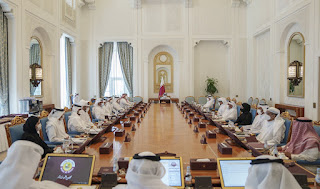The history of Qatar spans from its first duration of human occupation to its formation as a modern state. Human occupation of Qatar dates back to 50,000 years ago, and Stone Age encampments and tools have been unearthed in the peninsula.
The peninsula fell under the domain of several different empires during its early years of settlement, from 300BC to 600AD, including the Seleucid, the Parthians and the Sasanians, until Muhammad sent an envoy to a Persian ruler in Eastern Arabia named Munzir ibn Sawa Al Tamimi in 628 and requested that he and his people accept Islam. Munzir obliged his request and most Arab tribes in Qatar converted to Islam. Over the proceeding centuries, Qatar was a site of contention between the Wahhabi of Najd and the Al Khalifa.
Bahrain and mainland Qatar had been seized by the Portuguese in 1521. After the Portuguese claimed control, they constructed a series of fortresses along the Arabian Coast. The Portuguese focused on creating a commercial empire in Eastern Arabia, and exported gold, silver, silks, cloves, amber, horses and pearls. The population submitted voluntarily to the rule of the Ottomans in 1550, preferring them to the Portuguese.
The Ottomans expanded their empire into Eastern Arabia in 1871, withdrawing from the area in 1915 after the beginning of WWI.
In 1916, Qatar became a British protectorate and Abdullah Al-Thani signed a treaty stipulating that he could only cede territory to the British in return for protection from all aggression by sea and support in case of a land attack. A 1934 treaty granted more extensive protection. In 1935, a 75-year oil concession was granted to Qatar Energy and high-quality oil was discovered in 1940 in Dukhan. During the 1950s and 1960s, increasing oil revenues brought prosperity, rapid immigration, substantial social progress and the beginnings of the country's modern history.
Qatar declared its independence on 1 September 1971 and became an independent state on 3 September.
Fast forward 51 years, here I am in Qatar discussing with the Prime Minister and his cabinet their National Development Strategy what the state would be like in 2030 (their 60th year of independence) and none of the elements are trivial.
Today it is one of the wealthiest state in the world, in absolute and relative (GDP/capita) terms, thanks largely to its significant gas reserves. However, in today’s climate-challenged world and more critically, dwindling reserves, they need to diversify their economy amidst increasingly competitive nations in the gulf: all aiming to attract investors and talents to grow their economy.
We had to grapple with trade offs between economic development (growth and diversification targets) vs the social cohesion implications. We had to help define values of the nation: what to preserve vs what must be further developed based on their national identity and history.
While I was deep in debate with the supreme committee, D was on a private city and water tour of the capital. With her insightful mind, she understood the country right away. She noticed that much has been built, very quickly but are largely empty. They are creatively designed but few truly reflected the heritage and natural beauty of the land (except the desert rose inspired national museum of qatar).
Also, with all these new build, Qatar could have gotten the architects to lead the way with sustainable buildings but instead too many steel (from china) and glass (from US) buildings re erected which is also completely impractical for a place so easily covered in sand. Her summary of "fast and empty" encapsulates the monumental task Qatar has ahead for the coming years to reinvent itself.

No comments:
Post a Comment